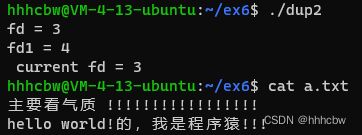Linux学习笔记——系统文件与目录操作函数
文章目录
- 文件操作函数
-
- 获取文件属性—stat、lstat、fstat
- 目录操作
-
- readdir 函数
- dup和dup2
- fcntl
文件操作函数
获取文件属性—stat、lstat、fstat
struct stat {
dev_t st_dev; //文件的设备编号
ino_t st_ino; //节点
mode_t st_mode; //文件的类型和存取的权限
nlink_t st_nlink; //连到该文件的硬连接数目,刚建立的文件值为1
uid_t st_uid; //用户ID
gid_t st_gid; //组ID
dev_t st_rdev; //(设备类型)若此文件为设备文件,则为其设备编号
off_t st_size; //文件字节数(文件大小)
blksize_t st_blksize; //块大小(文件系统的I/O 缓冲区大小)
blkcnt_t st_blocks; //块数
time_t st_atime; //最后一次访问时间
time_t st_mtime; //最后一次修改时间
time_t st_ctime; //最后一次改变时间(指属性)
};
st_mode 该变量占 2 byte,共 16 位:
(1) 掩码的使用: st_mode & 掩码
(2) 其他人权限( 0-2 bit )
(a) S_IROTH 00004 读权限
(b) S_IWOTH 00002 写权限 掩码:S_IRWXO 00007
(c) S_IXOTH 00001 执行权限
(3) 所属组权限(3-5bit)
(a) S_IRWXG 00070 读权限
(b) S_IRGRP 00040 写权限 掩码:S_RWXG 00070
(c) S_IXGRP 00010 执行权限
(4) 文件所有者权限(6-8bit)
(a) S_IRUSR 00400 读权限
(b) S_IWUSR 00200 写权限 掩码:S_IRWXU 00700
(c) S_IXUSR 00100 执行权限
(5) 文件特权位(9-11bit)
(a) S_ISUID 0004000 设置用户ID
(b) S_ISGID 0002000 设置组ID 文件特权位很少用
(c) S_ISVTX 0001000 设置黏住位
(6) 文件类型(12-15bit)
(a) S_IFSOCK 0140000 socket(套接字)
(b) S_IFLNK 0120000 symbolic link(符号链接--软连接)
(c) S_IFREG 0100000 regular file(普通文件)
(d) S_IFBLK 0060000 block device(块设备) 掩码:S_IFMT 017000
(e) S_IFDIR 0040000 directory(目录)
(f) S_IFCHR 0020000 character device(字符设备)
(g) S_IFIFO 0010000 FIFO(管道)
以上三个获取文件属性的函数 若成功,返回0;若失败,返回 -1
stat、lstat、fstat之间的区别
-
fstat函数:系统调用的是一个文件描述符,而另外两个则直接接收文件路径。文件描述符是我们用open系统调用后得到的,而文件全路径直接写就可以了。 -
stat函数与lstat函数的区别: 当一个文件是符号链接时,lstat函数返回的是该符号链接本身的信息(穿透);而stat函数返回的是该链接指向文件的信息(不穿透)。
#include#includectime 函数是将日历时间(这里是一个结构体)转化为字符串形式。
运行结果如下:

文件操作函数还有 access、chmod、chown、truncate、link、unlink、rename 等,用法都比较简单,参考最上面的图片以及man文档即可。
目录操作
readdir 函数
readdir 函数主要用于读目录,其函数原型如下:

dirent 结构体内容如下:
struct dirent {
ino_t d_ino; /* inode number */ // 目录进入点的 inode
off_t d_off; /* not an offset; see NOTES */ // 目录文件头开始至此目录进入点的位移
unsigned short d_reclen; /* length of this record */ // d_name的长度,不包括NULL字符
unsigned char d_type; /* type of file; not supported // d_name所指的文件类型
by all filesystem types */
char d_name[256]; /* filename */ // 文件名
};
其中 dtype 有八种类型
(1) DT_BLK This is a block device. 块设备
(2) DT_CHR This is a character device. 字符设备
(3) DT_DIR This is a directory. 目录
(4) DT_FIFO This is a named pipe (FIFO). 管道
(5) DT_LNK This is a symbolic link. 软链接
(6) DT_REG This is a regular file. 普通文件
(7) DT_SOCK This is a UNIX domain socket. 套接字
(8) DT_UNKNOWN The file type is unknown. 未知类型
下面实现递归读取指定目录所有文件,并输出总的文件数量。
#includedup和dup2
#include
可以看到 newfd 与 oldfd 对应同一个文件描述,其文件偏移是一样的。
#include
可以看到 dup2() 将 newfd 关闭了,并且 newfd 和 oldfd 对应同一个文件。
fcntl

fcntl 可以改变已打开文件的属性,下面使用 fcntl 将一个只写文件改为追加写。
#include




